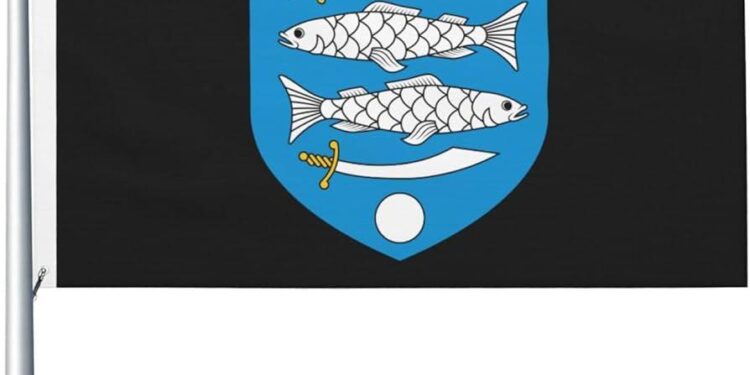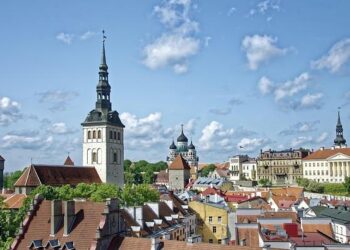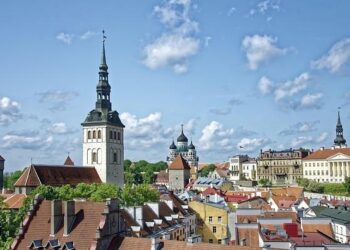Narva’s Defiant Display: A Stark Symbol of Estonia-Russia Tensions
In a bold political statement highlighting the mounting strain between NATO countries and Russia, the Estonian border city of Narva has unveiled a provocative banner depicting Russian President Vladimir Putin as Adolf Hitler. Positioned prominently on the historic walls of Narva Castle, this image faces directly toward Russian territory across the Narva River. It serves not only as a daring message but also as a powerful reminder of historical conflicts that still shape Eastern Europe’s geopolitical dynamics today. This act comes amid heightened concerns over Russia’s military actions and ongoing instability in Ukraine, emphasizing the delicate balance between national sovereignty and regional security.
A Symbolic Gesture Against Authoritarianism
The choice by Narva’s local authorities to display this contentious banner reflects deep-seated fears within Estonia about safeguarding its independence against perceived external threats. Portraying Putin in parallel with Hitler is intended to evoke more than mere insult; it draws a deliberate connection between contemporary authoritarianism and some of history’s most oppressive regimes. For many residents living on this frontline city bordering Russia, it represents steadfastness and resistance against encroaching influence.
Reactions among locals have been varied—while numerous citizens take pride in their community’s courageous defense of democratic values, others express apprehension about potential diplomatic fallout or escalated tensions with their eastern neighbor. Meanwhile, Moscow quickly denounced the installation as inflammatory propaganda aimed at sowing discord.
Narva Castle: Where History Meets Modern Political Realities
Standing at the juncture where centuries-old history converges with current geopolitical challenges, Narva Castle embodies Estonia’s turbulent past while playing an active role in present-day discourse. Located directly opposite Russia along the riverbank, this fortress has witnessed countless invasions and cultural transformations throughout its existence.
- A Heritage Forged Through Conflict: From medieval sieges to Soviet occupation during much of the 20th century, Narva Castle symbolizes resilience amid adversity.
- An Active Political Canvas: The recent use of its walls for politically charged imagery transforms it from mere monument into an engaged participant in debates surrounding sovereignty and identity.
- A Rallying Point for Unity: The banner reinforces collective memory while galvanizing citizens around shared ideals such as democracy and opposition to oppression—a sentiment echoed widely across Baltic nations since Russia launched its full-scale invasion three years ago.
Toward Reducing Baltic-Russian Hostilities: Strategic Pathways
The provocative nature of Narva’s banner underscores urgent calls for diplomatic efforts aimed at easing tensions within this sensitive region. Strengthening collaboration among Baltic states through NATO remains crucial for ensuring collective defense capabilities, while simultaneously exploring dialogue opportunities with Russia where possible.
Beyond formal diplomacy, fostering interpersonal connections can help dismantle long-standing mistrust:
- Cultural Initiatives: Hosting joint art exhibitions or music festivals celebrating intertwined histories could nurture mutual respect despite political divides.
- Academic Exchanges: Scholarship programs enabling students from both sides to study abroad encourage understanding among younger generations poised to shape future bilateral relations.
- Mediated Media Projects: Collaborative storytelling ventures can challenge entrenched narratives fueling hostility by emphasizing shared human experiences instead.
Together these approaches aim not only to bolster internal solidarity within Baltic nations but also extend goodwill toward ordinary Russians seeking peaceful coexistence amid geopolitical upheaval.
The Wider Context: Memory Politics, National Identity & Future Prospects
Narva’s striking visual protest resonates far beyond Estonia’s borders—highlighting how historical memory continues influencing nationalism and international diplomacy today. As Eastern Europe wrestles with legacies left by former empires alongside new conflicts triggered by events like Ukraine’s war—which has displaced over 7 million people according to UNHCR data from early 2024—symbols such as this banner become focal points for discussions on preserving identity versus pursuing reconciliation efforts.
This episode illustrates how artistic expressions can simultaneously provoke controversy yet spark essential conversations about defending sovereignty under threat—and how communities choose remembrance practices that will shape their futures amidst uncertainty.
Conclusion: A Potent Statement Amid Ongoing Challenges
The introduction of a banner likening Vladimir Putin to Adolf Hitler on historic castle walls adds another chapter in fraught Estonia-Russia relations marked by tension yet underscored by enduring resilience. Visible from Russian soil yet deeply rooted in Estonian heritage, it stands both as defiance against perceived authoritarian encroachment (see related EU legal actions here) and a call for vigilance grounded in historical consciousness.
This act is likely to reverberate through diplomatic arenas while fueling public debate around nationalism, memory politics, and regional security strategies moving forward—reminding all stakeholders that Eastern Europe’s complex past continues shaping its contested present.
















